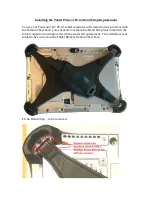
DIVERSIFIED METAL FABRICATORS, INC.
RW-1016
2-4
© 2017 DMF, Inc. All Rights Reserved
2.2
HIGHWAY OPERATION
Before operating a Railgear-equipped vehicle on the highway:
1.
Verify Railgear is in highway position.
2.
Verify that any pinoff systems (front and rear) are properly engaged (if equipped).
3.
Steering wheel lock has been removed (if applicable).
4.
Verify that any in-cab switches for Railgear system power remain off when operating on-
road.
2.3
GETTING ON THE RAIL
2.3.1
Getting Onto the Tracks
1.
At the track crossing, drive past the track, then back the vehicle onto the rails. Align the
rear Railgear to the rail first; this makes it easier to engage the front Railgear.
2.
Turn on the Railgear system power switch. Leave the truck running and in park, with the
parking brake set.
2.3.2
Lower Rear Guide Wheels
1.
Disengage the rear Railgear pinoff system (if equipped). If a pinoff is difficult to disengage,
momentarily press the “up” button on the Railgear co
ntrols to remove load from the pin.
2.
Use the wireless remote to lower the rear guide wheels. The flanges of the guide wheels
should be to the inboard sides of the railheads. It may be necessary to adjust truck position
slightly.
3.
When both wheels are fully down and properly engaging rail, engage the pinoff (if
equipped).
2.3.3
Lower Front Guide Wheels
1.
If necessary, drive the truck into position to line up the front guide-wheels with the rail.
2.
Ensure that the front Railgear pinoff is disengaged (if equipped).
3.
Ensure that the vehicle tires are pointed straight ahead.
4.
Use the wireless remote to lower the front guide wheels.
5.
Once Railgear is fully engaged on rail, re-engage the front pinoff (if equipped).
6.
Turn off the Railgear system power when not in use to prevent unintended movement.
7.
Install the Velcro steering wheel lock between the top of the steering wheel and the steering
column.
8.
Disengage the truck’s parking brake when you are ready to proceed.
2.3.4
On the Tracks
Recommendations given here are for welded rail in good condition. Jointed rail or rail in poor
condition, require further reductions in speed and additional caution.
Do not exceed posted track speed limit, and at no time exceed 40 MPH while on the track.
Operator is responsible for determining safe speed.
All four guide wheels on RW-1016 Railgear are typically insulated and
will not
operate
crossing gate circuits. Optional switchable shunt systems can be installed to selectively
control when the vehicle will be detected on rail.
Reduce speed while in reverse and/or at all crossings, curves, branch lines, switches and
frogs (no more than a slow walking pace is recommended).
Traction is reduced on the track, especially in wet conditions.
Braking distance is increased on the track, especially in wet conditions.
Do not slide tires or guide wheels on the tracks as this will cause premature wear.
Do not exceed the maximum rated capacity of the equipment.
Summary of Contents for RW-1016
Page 22: ......
Page 30: ......
Page 46: ......
Page 47: ......
Page 48: ......
Page 54: ......
Page 55: ......
Page 56: ......
Page 59: ......
Page 60: ......
Page 97: ...2017 DMF Inc All Rights Reserved Page 4 of 4 Page left intentionally blank...
Page 102: ...2017 DMF Inc All Rights Reserved Page 5 of 5 Page left intentionally blank...
Page 107: ...2017 DMF Inc All Rights Reserved Page 5 of 5 Page left intentionally blank...
Page 110: ...DIVERSIFIED METAL FABRICATORS INC RW 1016 2017 DMF Inc All Rights Reserved...














































